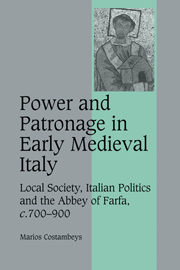 Power and Patronage in Early Medieval Italy
Power and Patronage in Early Medieval Italy Book contents
- Frontmatter
- Contents
- List of illustrations
- Acknowledgements
- Note on charter editions
- List of abbreviations
- Maps
- 1 INTRODUCTION
- 2 PATRONAGE AND LOMBARD RULERS
- 3 AUTHORITY, RULERSHIP AND THE ABBEY
- 4 THE MONKS AND ABBOTS OF FARFA: IDENTITIES AND AFFILIATIONS
- 5 SABINE LANDS AND LANDOWNERS
- 6 ELITE FAMILIES IN THE SABINA
- 7 FARFA AND ITALIAN POLITICS IN THE LOMBARD ERA
- 8 FARFA, ITALIAN POLITICS AND THE CAROLINGIANS
- Bibliography
- Index
- Cambridge Studies in Medieval Life and ThoughtFourth Series
1 - INTRODUCTION
Published online by Cambridge University Press: 17 July 2009
- Frontmatter
- Contents
- List of illustrations
- Acknowledgements
- Note on charter editions
- List of abbreviations
- Maps
- 1 INTRODUCTION
- 2 PATRONAGE AND LOMBARD RULERS
- 3 AUTHORITY, RULERSHIP AND THE ABBEY
- 4 THE MONKS AND ABBOTS OF FARFA: IDENTITIES AND AFFILIATIONS
- 5 SABINE LANDS AND LANDOWNERS
- 6 ELITE FAMILIES IN THE SABINA
- 7 FARFA AND ITALIAN POLITICS IN THE LOMBARD ERA
- 8 FARFA, ITALIAN POLITICS AND THE CAROLINGIANS
- Bibliography
- Index
- Cambridge Studies in Medieval Life and ThoughtFourth Series
Summary
FARFA AND THE POLITICS OF MONASTICISM IN EARLY MEDIEVAL ITALY
The same apostolic lord not only recognized that he himself had no lordship over the rights of that monastery, except consecration, but also reinvested Leo, who was advocate of our party and of the same monastery, with all the properties located both in the Sabine territory and in Romania, which the power of the predecessors of the same Pope Paschal had unjustly taken away from the same monastery through their orders.
The diploma from which this quotation is taken, issued by Emperor Lothar I in December 840, was not the first attempt by a Carolingian emperor to settle matters between the abbey of Farfa and the papacy in the monastery's favour; it was not even Lothar's first attempt. The repeated efforts of Farfa's abbots to stave off the threat of papal domination by appeal to the greatest secular power in the region do not simply indicate the feature of the abbey most often emphasized by the historiography – that is, its imperial affiliation. The fact that those efforts had to be repeated – that the issue of the control of the abbey and (perhaps especially) its patrimony had to be continually revisited – also highlights quite how precarious was the situation in which the abbey found itself for most of the first four hundred years of its existence. It was precarious, but also influential.
- Type
- Chapter
- Information
- Power and Patronage in Early Medieval ItalyLocal Society, Italian Politics and the Abbey of Farfa, c.700–900, pp. 1 - 61Publisher: Cambridge University PressPrint publication year: 2007


